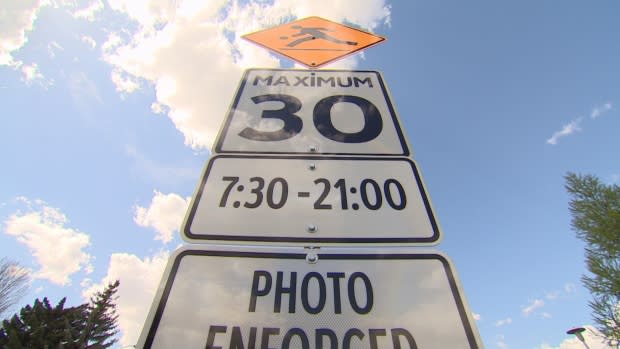Commitee orders further research on variable playground speeds
Edmonton's "one-size-fits-all" rule for playground speed zones — regardless of time of day or season of the year — is better than confusing motorists with variable rules, says a report reviewed by city councillors on Tuesday.
City administrators re-evaluated the harmonized playground zones that were brought into effect in September 2017. There are almost 400 such zones, including standalone playgrounds and school zones, in which the speed limit is 30 km/h every day from 7:30 a.m. to 9 p.m.
The review was requested by councillors who were hearing from frustrated motorists that the restricted speed doesn't always make sense.
"The approach that we've taken, similar to Calgary, is that we provide some certainty so that motorists have a better understanding of when they are needing to travel at a specific speed," deputy city manager of city operations Gord Cebryk said Tuesday.
But the report didn't convince the Urban Planning Committee Tuesday as it voted to have city administration do further research.
"I think we could've had more information today that would've essentially ended this particular part of this discussion," said Coun. Tim Cartmell.

Administration will now review information from other jurisdictions that employ a variable "one hour after sunset" or "when pedestrians are present" approach.
Tuesday's report listed municipalities employing variable sunset speed limits but only pulled data from Edmonton and Calgary.
Calgary has had 30 km/h playground zone speeds during consistent hours since 2015. A University of Calgary study two years ago found both speeds and pedestrian collisions in these zones subsequently decreased.
While Mayor Don Iveson supported further research, he said the current system is effective in its simplicity.
"I think it makes sense to have it just be a fixed set of hours all the time because it's very clear and easy to understand," he said.
'One size doesn't fit all'
"In the middle of January, it's minus 20 out, and I'm driving past this white asphalt called a soccer field. Why am I driving 30 kilometres an hour?" Coun. Mike Nickel said Tuesday on CBC Radio's Edmonton AM.
"The point here is one size doesn't fit all. Mill Woods is not Ritchie. The neighbourhoods are built different. Strathern is not like Oliver. ... Taking a one-size-fits-all approach doesn't gets us the result we want."

Nickel, a member of the urban planning committee, wants something with more flexibility, such as seasonal playground zones where the lower speed limit ends earlier in winter.
Seasonal hours for all playground zones was one of the three options outlined by the city report. Another option would maintain the speed limit and hours at all school zones but would offer seasonal time changes for standalone playgrounds. The third option was to leave things as they are.
That's the option city administrators are advising, pointing out that inconsistent hours will lead to more driver confusion.
"Playground zones have been in effect for less than one year and drivers are still adjusting to the playground locations and effective times," stated the report.
"Making changes to playground zone hours now would negatively impact driver and pedestrian safety."
Confusion could be influenced by a number of factors, the report said.
For example, enforcement speed limits during the hours between sunrise and sunset would be tricky, because most drivers won't be aware of the exact times. Similarly, aligning school zone speed limits to operational days gets complicated by the varying schedules of different school boards.
Nickel acknowledged that implementing variable speed limits would require more effort.
"Politicians are terrible, thinking that there's a magic bullet solution," he said. "You've just got to work at it, because there's lots of variables that go into it."
He said measures to improve safety could include fences around playgrounds, on-site spaces for student drop-off and pick-up, or tickets with demerits — not just photo radar — to help change driver behaviour.
The report noted a 24-per-cent decrease in "vulnerable road user injury collisions" since the playground zones were brought in. However, it stressed, the zones are still too new to have amassed appropriate levels of data.
Maintaining the status quo, the reports said, would offer more time to build up statistical data that could speak to the impact of the playground zones.


